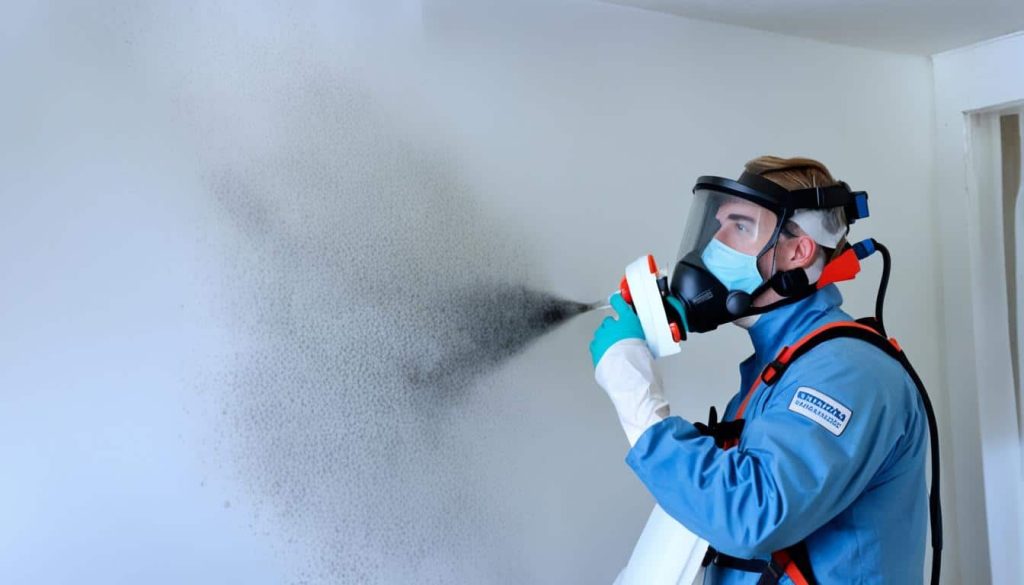What does Black mold look like, particularly Stachybotrys chartarum, is a name that strikes fear in the hearts of homeowners due to its notorious health risks. However, not all black mold is Stachybotrys, and distinguishing between different types of mold based on appearance alone can be misleading and dangerous. In my career as a mold expert, I have encountered over 1,000 mold-related issues, ranging from visibly obvious black mold to cases where no visible mold was present, yet air samples indicated large quantities of Stachybotrys. This guide aims to shed light on the complexities of identifying black mold, the importance of professional testing, and why expert intervention is crucial.
Array of Solutions, a trusted name in mold removal in Greenville South Carolina since 2007, stands ready to tackle your mold woes. With our expert mold inspection Greenville services and EPA-Registered credentials, we’re equipped to detect, remove, and prevent mold growth in your home or business.
Table of Contents
The Myth of Visual Identification
What Does Black Mold Look Like?
Many people believe that they can identify Stachybotrys simply by looking for black mold patches. Unfortunately, this belief is one of the most common and dangerous myths in mold identification. The truth is, without proper testing and inspection, it’s impossible to definitively identify whether black mold is Stachybotrys or another species. Several molds, such as Aspergillus, Penicillium, and Cladosporium, can also appear black but differ significantly in toxicity and behavior.

Why Visual Identification Is Inadequate
- Color Variability: Stachybotrys typically presents as dark greenish-black, but other molds can also appear in similar shades. Additionally, molds can change color based on the substrate they grow on, the availability of nutrients, and environmental conditions.
- Texture Differences: While Stachybotrys is often slimy and has a slightly shiny appearance due to its high moisture content, other molds may appear dry and powdery or velvety. However, texture alone is not a reliable indicator of mold type.
- Growth Patterns: Stachybotrys usually grows in patches that can spread over time, but its growth pattern can mimic that of other molds. The spread of mold is influenced by the availability of moisture, and identifying mold based on growth patterns alone is not sufficient.
The Role of Professional Mold Testing
Why Testing Is Crucial
The only way to accurately determine whether black mold is Stachybotrys or another species is through professional testing. At Array of Solutions, we use advanced methods to collect and analyze mold samples, ensuring that we correctly identify the type of mold present in your home or business. Testing provides several key benefits:
- Accurate Identification: Laboratory testing can differentiate between various types of mold, including those that may appear similar to Stachybotrys but are less harmful.
- Health Risk Assessment: Once the mold type is identified, we can assess the potential health risks associated with exposure, particularly for vulnerable individuals such as those with allergies, asthma, or compromised immune systems.
- Tailored Remediation: Understanding the exact type of mold allows us to tailor our remediation approach, ensuring that the mold is effectively eradicated and does not return.
Our Testing Process
- Initial Consultation: We begin with a thorough consultation to understand your concerns and assess visible mold growth, moisture sources, and potential hidden mold.
- Sampling: Samples of the suspected mold are collected using industry-standard techniques. We may take samples from visible growths, air, and surfaces to get a comprehensive understanding of the mold issue.
- Laboratory Analysis: The samples are sent to a nationally accredited laboratory for analysis. The lab will identify the type of mold and provide a detailed report on its concentration and potential health impacts.
- Customized Plan: Based on the lab results, we create a customized remediation plan to address the specific mold issue, whether it is Stachybotrys or another type of mold.
The Dangers of Misidentification
Health Risks of Stachybotrys
Stachybotrys is one of the most dangerous molds due to its ability to produce mycotoxins, which can cause severe health issues, including respiratory problems, chronic fatigue, and even neurological symptoms. Exposure to Stachybotrys is particularly hazardous for infants, elderly individuals, and those with pre-existing health conditions.
False Sense of Security
Misidentifying black mold can lead to a false sense of security. Homeowners may mistakenly believe that the mold in their home is harmless when, in fact, it could be a serious health threat. Conversely, overreacting to non-toxic black mold can lead to unnecessary stress and expense.
When to Call a Mold Expert
Signs You Need Professional Help
- Visible Mold Growth: Any visible black mold should be evaluated by a professional, especially if it covers a large area or is recurring.
- Musty Odors: A persistent musty odor, particularly in areas prone to moisture, can indicate hidden mold growth, even if no visible mold is present.
- Health Symptoms: If you or your family members are experiencing unexplained health issues such as coughing, sneezing, or headaches, it may be due to mold exposure.
- Water Damage: After any significant water damage, such as a flood or leak, it is important to have the area inspected for mold, as moisture is a key factor in mold growth.

Conclusion: Trust the Experts
Understanding what black mold looks like is more complex than simply identifying a color. Without professional testing and expertise, it is impossible to accurately identify and effectively treat mold, particularly the potentially dangerous Stachybotrys. At Array of Solutions, we provide comprehensive mold testing and remediation services to protect your health and property. Don’t take chances with your safety—contact us today for a consultation.
